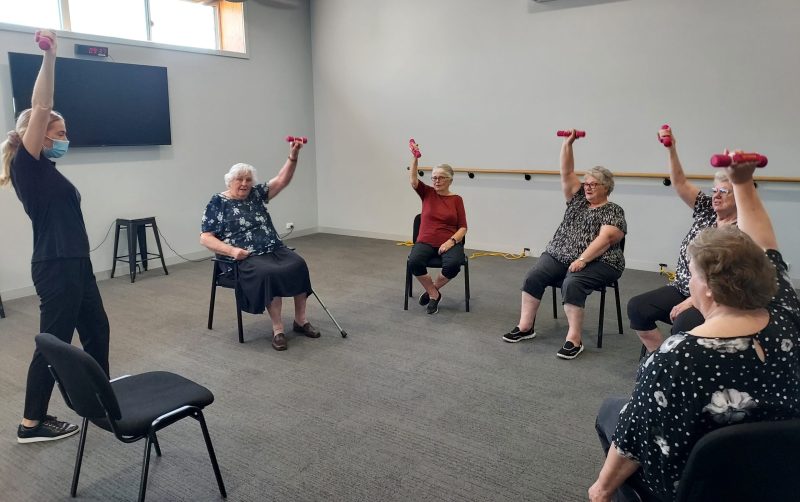As the Australian population continues to age, we at O-health want to do the best we can to keep the Albury community strong, functional and independent for as long as possible.
In Australia, for adults aged 65 and older, 75% are not sufficiently active. The Australian Physical Activity and Sedentary Behaviour Guidelines recommend that adults should complete at least 30 minutes of moderate intensity physical activity on most days, no matter their age, weight, health conditions or abilities.
Physical activities include; exercise (something that is planned, structured and repetitive), playing sports, activities of daily living (vacuuming, gardening, cleaning the house) and leisure or active transportation (walking, riding the bike).
Being physically active is important to maintain or improve physical function, which helps to keep us independent to perform activities of daily living.
Benefits of Exercise include:
- Maintaining or increasing quality of life, health and physical function
- Increasing balance and reducing risk of falls and injury
- Improving cognitive function
- Reduce cardiovascular disease and risk factors
- Improving quality of sleep
- Decreasing fatigue
- Increasing mood
- Increase lean muscle, bone density and joint health
- Prevent muscle loss associated with ageing
Physical activity recommendations:
- Aerobic Exercise (walking, cycling, swimming or activities that increase your heart rate)
– Most days of the week, aiming for around 30 minutes per day (this can be completed in bouts of 5 to 10 minutes to start) or at least 150 minutes of exercise across the week. - Strength Training or resistance training
– Two to three days per week, 8-10 exercises involving major muscles groups (lower body, upper body, chest, back) with a rest day between workouts.
– Resistance training can be using your own body weight or household items, lifting weights or using machines, bands or balls if you have access to a gym.
– Examples: carrying shopping bags, yoga, pilates, tai chi, gardening (such as digging and shoveling). - Balance Exercises
– Two to three sessions per week.
– Combination of balance training, strength and aerobic sessions are most beneficial for older adults. It can increase your flexibility and reduce pain when moving.
– Like all exercises, balance training should be progressed to challenge the individual, starting with stable positions to less stable positions
– Example: holding rails, to not holding rails. Adding thinking tasks like naming items whilst standing with one foot in front of the other or counting backwards by 3’s from 30.
At O-health, our overall goal for our older clients is to assist in increasing their independence, and maintaining or increasing your physical and mental well-being for as long as we can.
To help with this, O-health run group classes specifically for older adults in the area.
There are many group classes ranging from gentle exercises incorporating both seated and standing aerobic, resistance and balance exercises with a coordination or cognitive tasks at the end to being the group together. To more advanced classes that incorporate standing exercises and floor-based exercises.
If this sounds like something you or someone you know would be interested in, feel free to give us a call.
If you are uncertain if the class is the best fit for you, you can have a trial class, or speak to one of our health professionals for more information.

FAQs
FAQ: What if I am not currently exercising, or have never exercised before?
A: At O-health, we have experienced practitioners who will look after you to ensure you begin exercising safely, and at an appropriate level.
It is never too late to start, and no goal is too big or too small. There are no expectations, and our practitioners will guide and support you along your journey.
FAQ: I am unable to get down and back up off the ground, can I still do an exercise class?
Yes, absolutely. Our team will ensure we find the right class for you, and some of our exercise classes include only seated and standing exercises.
FAQ: Is there anything I can do to help reduce my risk of developing osteoporosis?
A: Yes there is! Land-based strength exercises (think sit to stand, step ups, calf raises) are the best thing you can do to maintain and improve your bone density health.
It will not only help you reduce the risk but will also help you manage osteoporosis if you have already been diagnosed.
FAQ: I’m worried about falling, can I do anything about it?
A: Yes! Falling, or the fear of falling can reduce quality of life, loss of confidence and loss of independence. There are many things we can do to prevent falling and reduce your risk of falling.
We can split these into two categories- intrinsic factors (to do with you as an individual) and extrinsic factors (what we can change in the environment around us).
Intrinsic Factors
- Balance: You can work on your balance with exercise to make you feel more steady on your feet and more confident doing everyday tasks.
- Strength: Like balance, this is something you can always improve with the right exercises.
Better muscle strength will reduce your risk of falling. - Regular eye checks: Check in with your optometrist regularly as blurry vision and poor depth perception will increase your risk of falling.
- Bladder and bowel concerns: You can speak to your GP or health professional about any changes in bladder or bowel control.
Increased urgency can cause you to rush unnecessarily. - Side effects of medication: Speak to your GP regularly if you take regular medication and have a change in side effects.
Extrinsic Factors
- Tripping hazards: Remove clutter from your home.
Rugs can roll up or move without us realising. Remove any rugs if possible. - Wear well fitting shoes or slippers: Poorly fitting footwear increases chances of slipping or tripping.